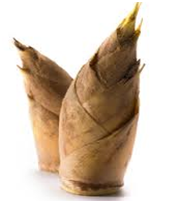
Bamboo plant is a member in the grass family. After about 3-4 years of implantation, a new shoot arises from the underneath root-system which is then gathered, and eaten as vegetable.
Bamboo shoots begin to appear above the ground surface in different seasons depending up on the species. When a young, cone-shaped new shoot just appears above the ground surface, it is severed from its root attachment, generally using a spade.
On its exterior, the shoot features several layers of tough casing of leaves, firmly wrapped around its central cream-white heart (meat). This prized meat is what the edible portion of bamboo shoot. It is crunchy in texture, and has mild yet distinctive flavor. Once boiled and cured, it however, acquires almost a neutral taste.
Health benefits of bamboo shoots
- Bamboo shoots are one of very low calorie vegetables. 100 g fresh canes hold just only 27 calories.
- Bamboo heart compose of moderate levels of soluble and non-soluble (NSP-non starch carbohydrates) dietary fiber. 100 g of fresh shoots provide 2.2 g of roughage. Dietary fiber helps control constipation conditions, decrease bad (LDL) cholesterol levels by binding to it in the intestines. Studies suggest that high-fiber diet can help cut down colon-rectal cancer risk by protecting intestines from the toxic compounds in the food.
- Bamboo hearts are also rich in B-complex group of vitamins such as thiamin, riboflavin, niacin, vitamin B-6 (pyridoxine), and pantothenic acid those are essential for optimum cellular enzymatic and metabolic functions.
- Bamboo is good in minerals, especially manganese and copper. In addition, it has small amounts of some essential minerals and electrolytes such as calcium, iron, and phosphorus. Manganese is utilized by the human body as a co-factor for the antioxidant enzyme, superoxide dismutase. Copper is required in the production of red blood cells. Iron is required for cellular respiration and red blood cell formation.
- Bamboo shoots compose an excellent levels of potassium. 100 g of fresh shoots hold 533 mg or 11% of daily required levels of potassium. Potassium is an important component of cell and body fluids that helps controlling heart rate and blood pressure by countering effects of sodium.
Selection and storage
Fresh bamboo shoots are a seasonal delicacy. If you are buying fresh shoots, look for the one harvested recently. Choose firm and heavy sprouts with wide base and intact leaves. Avoid soft, dry roots. Take a close look at the base of the shoot whether or not it turning to green hue. Greenish discoloration indicates that the root was exposed to sunlight for a long time, over-matured, and can be bitter in taste.
At home, fresh bamboo should be eaten as soon as they harvested. Otherwise, keep unpeeled whole bamboo shoot wrapped in a paper-towel and place inside the refrigerator where it can stay fresh for 1-2 days.
Preparation and serving methods
Raw bamboo shoots from the market should be processed before adding them in cooking. The whole process of shoot preparation consists of two steps; peeling its outer tough sheaths and de-toxification of its inner meat in order to remove bitter compounds. One of the easier methods to peel bamboo shoot is to cut it lengthwise into two halves. Then peel its outer leaves starting from the base and working on towards its tip. Tim away any tough portion at the base. Then dice the shoot to your desired sizes. Place the cubes in a bowl of cold water to avoid them turn brown
De-toxification of thus prepared meat is generally done through treating it in boiling water. Bamboo shoots contain taxiphyllin, a cyanogenic glycoside, which should be removed before use them in cooking. Boiling in a bowl of uncovered salted water for about 20-25 minutes removes most of these glycosides. To be sure, discard this water and boil again in fresh water for another 5-10 minutes would make them completely safe to eat.
Safety profile
In general, boiled bamboo shoots can be well tolerated and allergic reactions are quite rare to occur.
Bamboo shoots contain taxiphyllin, a cyanogenic glycoside. Cyanide alkaloids inhibit cytochrome-oxidase, an important enzyme in cellular respiration. Over-matured shoots and certain varieties of bamboo possess higher concentration of these glycosides than young, tender and some sweet varieties. Treating the tender shoot in boiling water readily degrades these toxic compounds. (Medical disclaimer).
【Reference】






